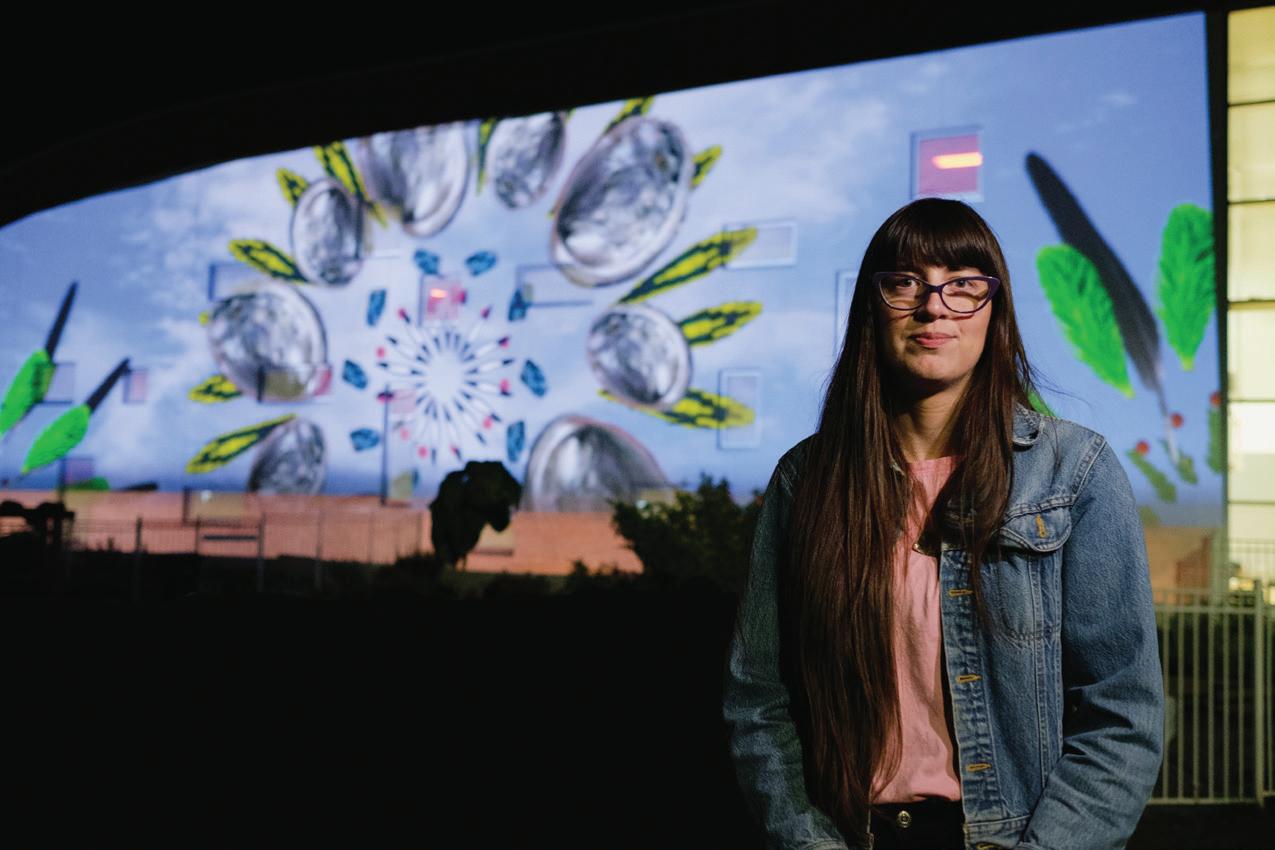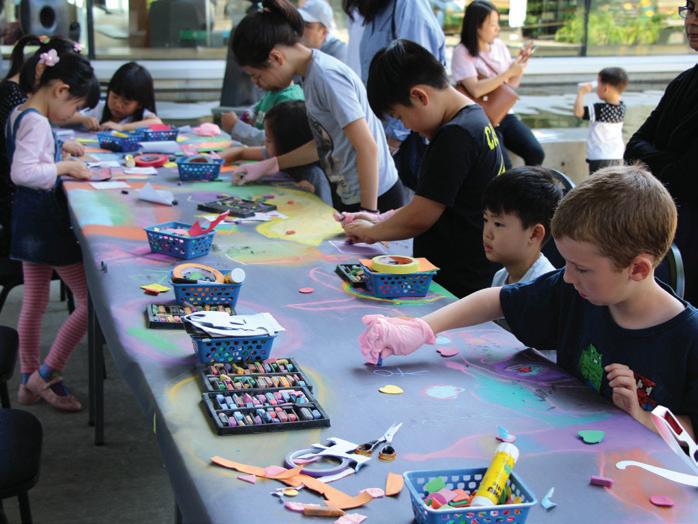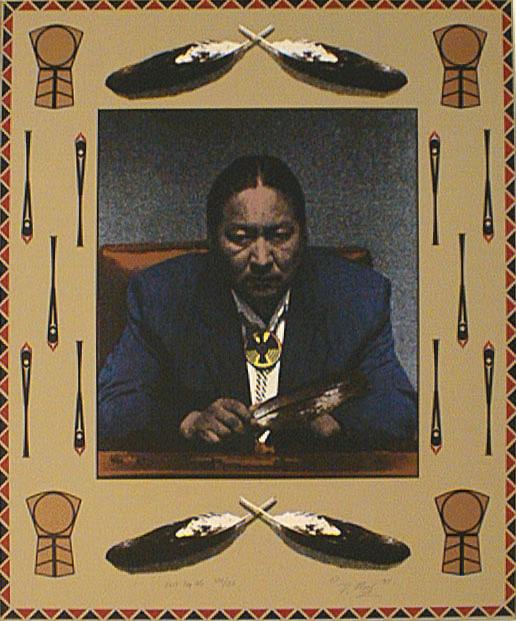
6 minute read
Language is culture is art
Surrey Art Gallery’s education & engagement
Alanna Irene Edwards Engagement Facilitator and Gallery Education team: Surrey Art Gallery
Advertisement

The author Alanna Edwards in front of her UrbanScreen artwork piptugwagit (2018).
Pardeep Singh
Language is more than the spoken word. Shapeshifting and transforming from one person, one family, and from one community to the next, language encompasses many forms. It can be the hug from an Elder after divulging a secret, the silent shared looks between friends, to pursed lips pointing the way, and the hunched, tired, but grateful way your dad walks home from a hard day’s physical labour. Language is imprinted on the body; felt, understood, and ingrained in ourselves. We have and always will find ways to communicate, understand interpret, and resist, especially when languages, and all that they embody, are the defining elements of who we are. Considering the immense rate in which many Indigenous languages, and their culturally codified means of communication, have been lost or taken away, there is an increased desire and need to preserve, protect, and revitalize them for future generations. Visual art is one way to help support these initiatives.

Cathy Busby and Charlene Vickers with Art Together participants using their voice and soundmakers in relation to Ground Signals exhibition in 2017.
Gallery staff
Listening to communities & moving forward together
Language, art, and culture are so deeply intertwined and interwoven that one cannot exist without the other. The variety and complexity of art by Indigenous peoples on Turtle Island demonstrates art as complex cultural forms of written language. Local Indigenous languages have a strong connection to the land they occupy, where language and storytelling allow opportunities to learn about the environment and land in different ways. Surrey Art Gallery’s education and engagement programming strives toward deepening understanding and learning related to the use of language, storytelling, and voice by local and national Indigenous artists, prioritizing working with artists from land-based nations q̓ʷɑ:n̓ƛ̓ən̓ (Kwantlen), Semiahma (Semiahmoo), and q̓ic̓əy̓ (Katzie). Serving the growing population of Surrey – currently the largest urban Indigenous population in BC – and supporting the needs of teachers in the province’s largest school district, the gallery continues a history of listening, valuing, and supporting the voices of the communities it serves.

During Family Art Party in summer 2019, children work collaboratively on an artwork referencing the use of visual language and storytelling in Drew Atkins’ RetroPerspective (2018).
Gallery staff
Using our collective voices: family & youth programming
From a collaborative weaving performance with artist and art-educator Roxanne Charles of the Semiahmoo First Nation during Art Together, to the representation and reference of pictographs in Marianne Nicolson’s UrbanScreen artwork The Way In Which It Was Given to Us (2017), voice and culture are reclaimed and celebrated through visual and performance art. Family and youth programming, and learning related to sharing the permanent collection, are informed and strengthened through working collaboratively with artists and the public.
During the summer of 2018, a pilot initiative called the Indigenous Contemporary Art Intensive (ICAI) paired emerging artists with mentoring artists, culminating in UrbanScreen artworks and a series of recommendations for the Gallery to continue working on Indigenous contemporary art initiatives. Initiated by Roxanne Charles and then Curator of Education and Engagement Alison Rajah, Junior Cultural Leaders included Avishka Lakwijaya, Naomi Kennedy, Atheana Picha, and Kelsey Sparrow, with myself as Engagement Facilitator. Through mentorship, offsite visits, and workshops with artists like Drew Atkins, Debra Sparrow, Peter Morin, and Roxanne Charles, we grew our voices as artists and as cultural workers, gaining valuable skills in museum art education and expanding our own art practices.

Atheana Picha, member of the Indigenous Contemporary Art Intensive, in front of her artwork for UrbanScreen.
Pardeep Singh
Family Art Party in the summer of 2019 saw children and youth create a collaborative artwork while thinking through language, Coast Salish design elements, and the use of voice in Drew Atkin’s Retro-Perspective (2018). Flowing throughout the Gallery’s windows are stained-glass-like vinyl images depicting Coast Salish design elements like trigons, circles, and crescents alongside figures with raised hands in a gesture of welcome. Canoes, paddles, and silhouettes of a 300-year-old feast bowl and a 3,500-year-old stone wolf carving complete the public artwork. Asking participants “What’s Your Story?” while children, youth, and their families reflected on the ways in which body language, like the figure with raised hands, and Coast Salish visual language and design elements communicate without words.
Bringing together mentoring artists with the public, Art Together workshops encourage participants to use their voice. Cathy Busby and Charlene Vickers jointly led a workshop in relation to the exhibition Ground Signals (2017), where participants created sound makers reflecting on the relationship between nature and humankind, ways in which to listen to the land, and the connections to territory and place. The collaboratively-made, long rolled cones carried messages on their sides, including the word protect, that was used by the artists themselves as they performed at the opening night of Ground Signals.

Viewing Marianne Nicolson’s UrbanScreen artwork The Way In Which It Was Given to Us (2017).
Brian Giebelhaus
Deepening understanding: learning related to sharing the permanent collection
One of the recommendations from the ICAI led to the conceptualization of the forthcoming educational resource Visiting with, detailing 27 artworks in the Gallery’s permanent collection created by artists who are Indigenous. Mostly in words of the artists themselves with quotes and stories, the resource deepens understanding about land, community, language, and other relevant themes. The phrase, “visiting with” indicates our relationship not only to each other but to the art that we create. Like languages, objects and art are not static; they have a life of their own and exist in a dialogue and continuum with that which has come before.
Other educational resources for teachers, educators, and the public like online artist videos prioritize the voices, perspectives, and worldviews of the artists themselves. Brandon Gabriel from q̓ʷɑ:n̓ƛ̓ən̓ shares where he comes from, his practice, and details his public artwork created with his partner Melinda Bige titled Four Seasons (2016) at Chuck Bailey Recreation Centre. Gabriel describes himself as a storyteller, and that telling stories are the core of his work. Complementing the resource are two upcoming videos with Roxanne Charles, where she shares her perspective and connection to land, language, and community.
Also supporting the needs of teachers are the Indigenous Contemporary Art Workshops offered by the gallery throughout the Surrey School District. Since 1999, the Gallery has worked with Indigenous art-educators to visit schools and share the permanent and public art collections, supporting teaching and learning through hands-on art activities growing out of their own act practices. Students from K-12 learn about Northwest Coast and Coast Salish cultures and contemporary artmaking practices through an exploration of diverse artworks by Indigenous artists. BC’s new curriculum, the TRC’s Calls to Action, and the First Peoples Learning Principles continue to help inform the work the gallery does.

Susan Point’s Voices (1992) is one of the artworks in Surrey Art Gallery’s permanent collection to be included in the teacher’s resource visiting with.
Continuing sharing stories, ideas, perspectives
As the gallery continues to support the voices of Indigenous artists and the communities it serves, the gallery looks forward to supporting more opportunities and initiatives involving Indigenous languages, including hən̓q̓əmin̓əm̓ and other local languages, and learning related to the land and territory on which the Gallery sits. Acknowledging the power institutions have in creating change, the Gallery shares collective responsibility for supporting Indigenous contemporary art initiatives and learning through visual literacy and the arts.

Also to be included in visiting with, David Neel’s print Just Say No (1991) records the unforgettable moment when MLA Elijah Harper raised an eagle feather in Manitoba legislature, effectively stopping the Meech Lake Accord.
Alanna Edwards is an artist, curator, and educator of Mi’gmaq and settler descent. She is passionate about languages and language use, especially that of Mi’gmaq, and gratefully has been enrolled in nêhiyawêwin and hən̓q̓əmin̓əm̓ courses. She has a BA in Political Science and Gender, Sexuality, and Women’s Studies from Simon Fraser University, a Diploma in Fine Arts from Langara College, and a BFA from Kwantlen Polytechnic University. Currently, she is an Engagement Facilitator at Surrey Art Gallery, focusing on museum art education involving Indigenous contemporary art initiatives.








